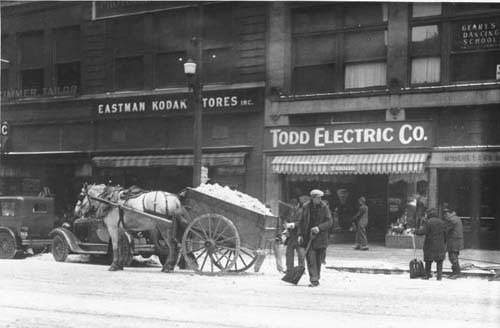Historic Images of Winter in Kansas City
As winter storm season arrives in Kansas City, we can take a look at winters past to see how the blizzards of today compare with the legendary snowstorms of yesteryear. Photographs and newspapers on microfilm in the Missouri Valley Special Collections at the Central Library tell stories of a city blanketed by snow and ice, trains slowed to a halt, and the cold weather taking its toll on the nerves and bodies of Kansas Citians.
Early automobile promoters and manufacturers were optimistic about the ability of cars to travel in winter weather, as an article and photograph in the November 1901 edition of the Kansas City Manufacturer indicates. The "locomobile" was built with a set of the narrowest snow tires ever produced and used the same steam that powered it to keep its driver warm.
The Manufacturer article boasts that this locomobile made the trip from Kansas City to Parkville "through the worst roads imaginable and on one of the most disagreeable days" of the winter of 1900-1901. However, traveling by car in the snow would prove to be a lasting challenge. Here two men attempt to push an automobile up Main Street from the River Market area during a 1928 storm.

Two decades later, during a 1949 blanketing, the two men pushing this car at 48th and Oak are not much better off.

Over the years a number of snow removal methods have been implemented to improve driving conditions. In this undated photograph of an early snow removal process, men at 9th and Grand scoop snow into a horse-drawn cart.
Before the age of modern plows and chemical "snowmelt" street treatments, the grainy remnants of burned coal, called cinders, were often used to provide traction on slick streets.

Travel by bus and train was hampered by the snowstorms of an earlier era, as well. The women in this 1949 photograph wait for a bus to arrive and provide a bit of shelter from the wind and snow.

Once aboard, however, they might encounter slow-moving and chaotic traffic like that pictured in this photograph taken during the same storm at 18th and Grand.

A headline in the February 12, 1894 Kansas City-Journal described the city as being "Knee Deep in the Beautiful," but an account of a disgruntled train passenger included later in the article indicates that opinions generally might have been quite the opposite:
One of the irate ones, a corpulent, well-dressed "bondholder" looking fellow on his way from San Francisco to New York, entered the depot doors wheezing like a porpoise, covered with snow, and loaded down with gripsacks. He had walked nearly a mile from the Missouri Pacific Denver Express, which had been stalled for several hours. As he entered the door of the depot a drummer, anxious for tidings of any moving trains, asked: "Where did you get in from?"
"Denver," was the curt reply.
"Have a rough trip?" queried the drummer, not to be squelched by a short answer.
"The blankety blankist blank blank trip this side of blank!" roared he of the perturbed mind and frustrated schedule.
However, the children of Kansas City have always held a more positive attitude toward snow and its effects, as these kids sledding near 68th and The Paseo demonstrate.

One also can’t deny that some of Kansas City's beloved landmarks have an enchanted look beneath a layer of the white stuff, as seen in these photos of the Nelson-Atkins Museum of Art, Liberty Memorial, and Union Station.



See more winter scenes from Kansas City's past in our local history online collection, or visit us here at the Missouri Valley Room on the 5th Floor of the Central Library at 14 W. 10th Street.


